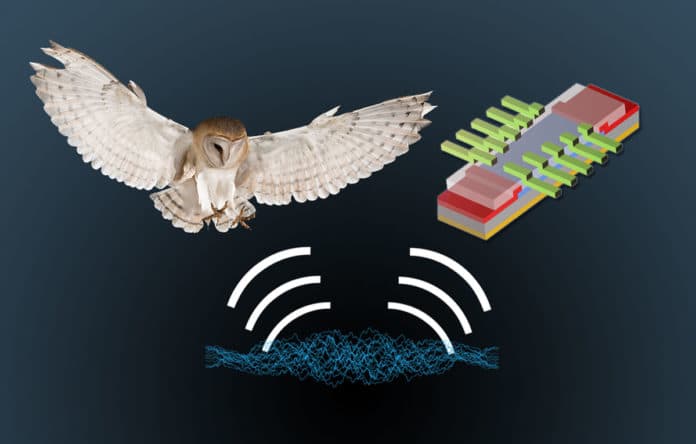The barn owl is a nocturnal predator with excellent sound localization ability. Due to the asymmetric ears of this bird, the interaural time and level differences, respectively, provide information for the horizontal and vertical direction of a sound source.
The manner barn owl minds utilize sound to find prey could inspire future directional navigation devices, suggests engineers at Penn State, as they are recreating owl brain circuitry in electronics.
Engineers are already studying this kind of circuitry when they stumbled across the Jeffress model of sound localization. The model, originally discovered in 1948 by Lloyd Jeffress, explains how biological hearing systems can enroll and dissect small differences in the arrival time of sound to the ears and after that find the sound’s source.
Saptarshi Das, assistant professor of engineering science and mechanics said, “Owls figure out which direction the sound is coming from to within one to two degrees. Humans are not that precise. Owls use this ability for hunting especially because they hunt at night and their eyesight isn’t all that good.”
The ability to use sound to find depends on the distance between the ears. In barn owls, that distance is very small, yet the brain’s circuitry has adjusted to being able to discriminate this small contrast. If the owl is confronting the sound source, then both ears get the sound all the while. If the sound is headed toward the right, the correct ear enrolls the sound marginally before the left.
However, locating objects by sound is not that simple. The speed of sound is faster than the owl’s nerves can function so after the owl brain converts the sound to an electrical pulse, the pulse is slowed down. Then the brain’s circuitry uses a lattice of nerves of different lengths with inputs from two ends, to determine which length is where the two signals coincide or arrive at the same time. This provides the direction.
Inspired by this mechanism, engineers have created an electronic circuit that can slow down the input signals and determine the coincidence point, mimicking the working of the barn owl brain. They have developed a series of split-gate molybdenum sulfide transistors to mimic the coincidence nerve network in the owl’s brain.
Split gate transistors generate output when both sides of the gate match, so only the gate tuned to a specific length will register the sound. This newly developed circuitry uses the same time-delay mechanism to slow down the signal.
Currently, the circuit uses standard substrates and device types, yet scientists believe that using 2D materials for the devices could offer more precision and make them more energy-efficient as the number of split-gate transistors could be increased, providing more precise coincidence times. The reduction in power consumption would benefit devices working in the low-power domain.
Sarbashis Das, a graduate student in electrical engineering said, “Millions of years of evolution in the animal kingdom have ensured that only the most efficient materials and structures have survived. In effect, nature has done most of the work for us. All we have to do now is adapt these neurobiological architectures for our semiconductor devices.”
Akhil Dodda, a graduate student in engineering science and mechanics said, “While we are trying to make energy-efficient devices, mammalian computing backed by natural selection has necessitated extreme energy-efficiency, which we are trying to mimic in our devices.”
Saptarshi Das said, “However, having only the direction will not provide the location of the sound source. To actually navigate or locate, a device would need to know the height of the sound source as well. noted that height is a property of the intensity of the sound and the researchers are working on this aspect of the problem.”
“There are several animals that have excellent sensory processing for sight, hearing, and smell. Humans are not the best at these.”
Engineers are now taking a gander at different creatures and other sensible circuitry for future research. While existing examination in the field of neuromorphic computing focuses around emulating the intellectual capacity of the human brain, this work reveals insight into a substitute methodology by imitating the super sensors of the set of all animals.
